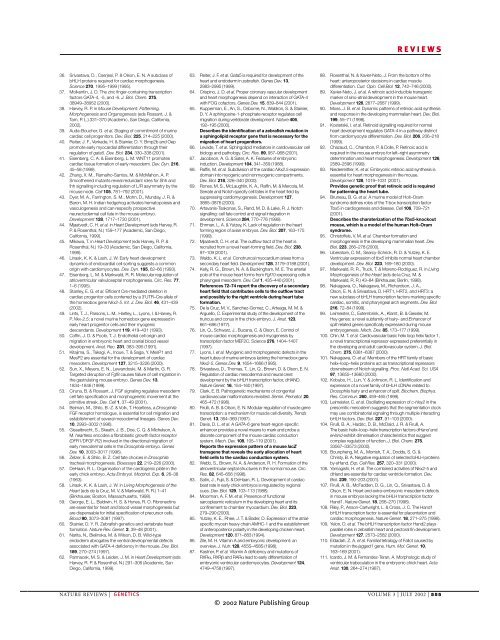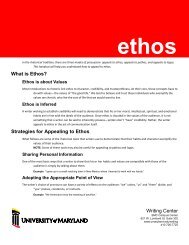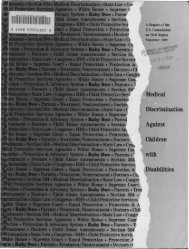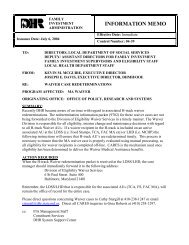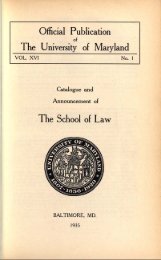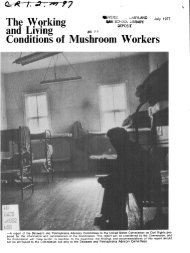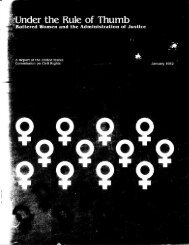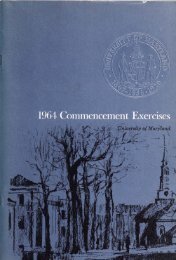PatterningHeartNatReviewsGen02.pdf
PatterningHeartNatReviewsGen02.pdf
PatterningHeartNatReviewsGen02.pdf
Create successful ePaper yourself
Turn your PDF publications into a flip-book with our unique Google optimized e-Paper software.
REVIEWS36. Srivastava, D., Cserjesi, P. & Olson, E. N. A subclass ofbHLH proteins required for cardiac morphogenesis.Science 270, 1995–1999 (1995).37. Molkentin, J. D. The zinc finger-containing transcriptionfactors GATA-4, -5, and -6. J. Biol. Chem. 275,38949–38952 (2000).38. Harvey, R. P. in Mouse Development: Patterning,Morphogenesis and Organogenesis (eds Rossant, J. &Tam, P. L.) 331–370 (Academic, San Diego, California,2002).39. Auda-Boucher, G. et al. Staging of commitment of murinecardiac cell progenitors. Dev. Biol. 225, 214–225 (2000).40. Reiter, J. F., Verkade, H. & Stainier, D. Y. Bmp2b and Oeppromote early myocardial differentiation through theirregulation of gata5. Dev. Biol. 234, 330–338 (2001).41. Eisenberg, C. A. & Eisenberg, L. M. WNT11 promotescardiac tissue formation of early mesoderm. Dev. Dyn. 216,45–58 (1999).42. Zhang, X. M., Ramalho-Santos, M. & McMahon, A. P.Smoothened mutants reveal redundant roles for Shh andIhh signalling including regulation of L/R asymmetry by themouse node. Cell 105, 781–792 (2001).43. Dyer, M. A., Farrington, S. M., Mohn, D., Munday, J. R. &Baron, M. H. Indian hedgehog activates hematopoiesis andvasculogenesis and can respecify prospectiveneurectodermal cell fate in the mouse embryo.Development 128, 1717–1730 (2001).44. Mjaatvedt, C. H. et al. in Heart Development (eds Harvey, R.P. & Rosenthal, N.) 159–177 (Academic, San Diego,California, 1999).45. Mikawa, T. in Heart Development (eds Harvey, R. P. &Rosenthal, N.) 19–33 (Academic, San Diego, California,1999).46. Linask, K. K. & Lash, J. W. Early heart development:dynamics of endocardial cell sorting suggests a commonorigin with cardiomyocytes. Dev. Dyn. 195, 62–66 (1993).47. Eisenberg, L. M. & Markwald, R. R. Molecular regulation ofatrioventricular valvuloseptal morphogenesis. Circ. Res. 77,1–6 (1995).48. Stanley, E. G. et al. Efficient Cre-mediated deletion incardiac progenitor cells conferred by a 3′UTR–Cre allele ofthe homeobox gene Nkx2-5. Int. J. Dev. Biol. 46, 431–439(2002).49. Lints, T. J., Parsons, L. M., Hartley, L., Lyons, I. & Harvey, R.P. Nkx-2.5: a novel murine homeobox gene expressed inearly heart progenitor cells and their myogenicdescendants. Development 119, 419–431 (1993).50. Coffin, J. D. & Poole, T. J. Endothelial cell origin andmigration in embryonic heart and cranial blood vesseldevelopment. Anat. Rec. 231, 383–395 (1991).51. Kitajima, S., Takagi, A., Inoue, T. & Saga, Y. MesP1 andMesP2 are essential for the development of cardiacmesoderm. Development 127, 3215–3226 (2000).52. Sun, X., Meyers, E. N., Lewandoski, M. & Martin, G. R.Targeted disruption of Fgf8 causes failure of cell migration inthe gastrulating mouse embryo. Genes Dev. 13,1834–1846 (1999).53. Ciruna, B. & Rossant, J. FGF signaling regulates mesodermcell fate specification and morphogenetic movement at theprimitive streak. Dev. Cell 1, 37–49 (2001).54. Beiman, M., Shilo, B.-Z. & Volk, T. Heartless, a DrosophilaFGF receptor homologue, is essential for cell migration andestablishment of several mesodermal lineages. Genes Dev.10, 2993–3002 (1996).55. Gisselbrecht, S., Skeath, J. B., Doe, C. Q. & Michelson, A.M. heartless encodes a fibroblastic growth factor receptor(DFR1/DFGF-R2) involved in the directional migration ofearly mesodermal cells in the Drosophila embryo. GenesDev. 10, 3003–3017 (1996).56. Zelzer, E. & Shilo, B. Z. Cell fate choices in Drosophilatracheal morphogenesis. Bioessays 22, 219–226 (2000).57. DeHaan, R. L. Organisation of the cardiogenic plate in theearly chick embryo. Acta Embryol. Morphol. Exp. 6, 26–38(1963).58. Linask, K. K. & Lash, J. W. in Living Morphogenesis of theHeart (eds de la Cruz, M. V. & Markwald, R. R.) 1–41(Birkhauser, Boston, Massachusetts, 1998).59. George, E. L., Baldwin, H. S. & Hynes, R. O. Fibronectinsare essential for heart and blood vessel morphogenesis butare dispensable for initial specification of precursor cells.Blood 90, 3073–3081 (1997).60. Stainier, D. Y. R. Zebrafish genetics and vertebrate heartformation. Nature Rev. Genet. 2, 39–48 (2001).61. Narita, N., Bielinska, M. & Wilson, D. B. Wild-typeendoderm abrogates the ventral developmental defectsassociated with GATA-4 deficiency in the mouse. Dev. Biol.189, 270–274 (1997).62. Parmacek, M. S. & Leiden, J. M. in Heart Development (edsHarvey, R. P. & Rosenthal, N.) 291–306 (Academic, SanDiego, California, 1999).63. Reiter, J. F. et al. Gata5 is required for development of theheart and endoderm in zebrafish. Genes Dev. 13,2983–2995 (1999).64. Crispino, J. D. et al. Proper coronary vascular developmentand heart morphogenesis depend on interaction of GATA-4with FOG cofactors. Genes Dev. 15, 839–844 (2001).65. Kupperman, E., An, S., Osborne, N., Waldron, S. & Stainier,D. Y. A sphingosine-1-phosphate receptor regulates cellmigration during vertebrate development. Nature 406,192–195 (2000).Describes the identification of a zebrafish mutation ina sphingolipid receptor gene that is necessary for themigration of heart progenitors.66. Levade, T. et al. Sphingolipid mediators in cardiovascular cellbiology and pathology. Circ. Res. 89, 957–968 (2001).67. Jacobson, A. G. & Sater, A. K. Features of embryonicinduction. Development 104, 341–359 (1988).68. Raffin, M. et al. Subdivision of the cardiac Nkx2.5 expressiondomain into myogenic and nonmyogenic compartments.Dev. Biol. 218, 326–340 (2000).69. Rones, M. S., McLaughlin, K. A., Raffin, M. & Mercola, M.Serrate and Notch specify cell fates in the heart field bysuppressing cardiomyogenesis. Development 127,3865–3876 (2000).70. Artavanis-Tsakonas, S., Rand, M. D. & Lake, R. J. Notchsignalling: cell fate control and signal integration indevelopment. Science 284, 770–776 (1999).71. Ehrman, L. A. & Yutzey, K. Lack of regulation in the heartforming region of avian embryos. Dev. Biol. 207, 163–175(1999).72. Mjaatvedt, C. H. et al. The outflow tract of the heart isrecruited from a novel heart-forming field. Dev. Biol. 238,97–109 (2001).73. Waldo, K. L. et al. Conotruncal myocardium arises from asecondary heart field. Development 128, 3179–3188 (2001).74. Kelly, R. G., Brown, N. A. & Buckingham, M. E. The arterialpole of the mouse heart forms from Fgf10-expressing cells inpharyngeal mesoderm. Dev. Cell 1, 435–440 (2001).References 72–74 report the discovery of a secondaryheart field that contributes cells to the outflow tractand possibly to the right ventricle during heart tubeformation.75. De la Cruz, M. V., Sanchez-Gomez, C., Arteaga, M. M. &Arguello, C. Experimental study of the development of thetruncus and conus in the chick embryo. J. Anat. 123,661–686 (1977).76. Lin, Q., Schwarz, J., Bucana, C. & Olson, E. Control ofmouse cardiac morphogenesis and myogenesis bytranscription factor MEF2C. Science 276, 1404–1407(1997).77. Lyons, I. et al. Myogenic and morphogenetic defects in theheart tubes of murine embryos lacking the homeobox geneNkx2-5. Genes Dev. 9, 1654–1666 (1995).78. Srivastava, D., Thomas, T., Lin, Q., Brown, D. & Olson, E. N.Regulation of cardiac mesodermal and neural crestdevelopment by the bHLH transcription factor, dHAND.Nature Genet. 16, 154–160 (1997).79. Clark, E. B. Pathogenetic mechanisms of congenitalcardiovascular malformations revisited. Semin. Perinatol. 20,465–472 (1996).80. Firulli, A. B. & Olson, E. N. Modular regulation of muscle genetranscription: a mechanism for muscle cell diversity. TrendsGenet. 13, 364–369 (1997).81. Davis, D. L. et al. A GATA-6 gene heart-region-specificenhancer provides a novel means to mark and probe adiscrete component of the mouse cardiac conductionsystem. Mech. Dev. 108, 105–119 (2001).Reports the expression pattern of a mouse lacZtransgene that reveals the early allocation of heartfield cells to the cardiac conduction system.82. Webb, S., Brown, N. A. & Anderson, R. H. Formation of theatrioventricular septal structures in the normal mouse. Circ.Res. 82, 645–656 (1998).83. Satin, J., Fujii, S. & DeHaan, R. L. Development of cardiacbeat rate in early chick embryos is regulated by regionalcues. Dev. Biol. 129, 103–113 (1988).84. Moorman, A. F. M. et al. Presence of functionalsarcoplasmic reticulum in the developing heart and itsconfinement to chamber myocardium. Dev. Biol. 223,279–290 (2000).85. Yutzey, K. E., Rhee, J. T. & Bader, D. Expression of the atrialspecificmyosin heavy chain AMHC-1 and the establishmentof anteroposterior polarity in the developing chicken heart.Development 120, 871–883 (1994).86. Zile, M. H. Vitamin A and embryonic development: anoverview. J. Nutr. 128, 455S–458S (1998).87. Kastner, P. et al. Vitamin A deficiency and mutations ofRXRα, RXRβ and RARα lead to early differentiation ofembryonic ventricular cardiomyocytes. Development 124,4749–4758 (1997).88. Rosenthal, N. & Xavier-Neto, J. From the bottom of theheart: anteroposterior decisions in cardiac muscledifferentiation. Curr. Opin. Cell Biol. 12, 742–746 (2000).89. Xavier-Neto, J. et al. A retinoic acid-inducible transgenicmarker of sino-atrial development in the mouse heart.Development 126, 2677–2687 (1999).90. Moss, J. B. et al. Dynamic patterns of retinoic acid synthesisand response in the developing mammalian heart. Dev. Biol.199, 55–71 (1998).91. Kostetskii, I. et al. Retinoid signalling required for normalheart development regulates GATA-4 in a pathway distinctfrom cardiomyocyte differentiation. Dev. Biol. 206, 206–218(1999).92. Chazaud, C., Chambon, P. & Dolle, P. Retinoic acid isrequired in the mouse embryo for left–right asymmetrydetermination and heart morphogenesis. Development 126,2589–2596 (1999).93. Niederreither, K. et al. Embryonic retinoic acid synthesis isessential for heart morphogenesis in the mouse.Development 128, 1019–1031 (2001).Provides genetic proof that retinoic acid is requiredfor patterning the heart tube.94. Bruneau, B. G. et al. A murine model of Holt–Oramsyndrome defines roles of the T-box transcription factorTbx5 in cardiogenesis and disease. Cell 106, 709–721(2001).Describes the charaterization of the Tbx5-knockoutmouse, which is a model of the human Holt–Oramsyndrome.95. Christoffels, V. M. et al. Chamber formation andmorphogenesis in the developing mammalian heart. Dev.Biol. 223, 266–278 (2000).96. Liberatore, C. M., Searcy-Schrick, R. D. & Yutzey, K. E.Ventricular expression of tbx5 inhibits normal heart chamberdevelopment. Dev. Biol. 223, 169–180 (2000).97. Markwald, R. R., Truck, T. & Moreno-Rodriguez, R. in LivingMorphogenesis of the Heart (eds de la Cruz, M. &Markwald, R. R.) 43–84 (Birkhauser, Berlin, 1998).98. Nakagawa, O., Nakagawa, M., Richardson, J. A.,Olson, E. N. & Srivastava, D. HRT1, HRT2, and HRT3: anew subclass of bHLH transcription factors marking specificcardiac, somitic, and pharyngeal arch segments. Dev. Biol.216, 72–84 (1999).99. Leimeister, C., Externbrink, A., Klamt, B. & Gessler, M.Hey genes: a novel subfamily of hairy- and Enhancer ofsplit related genes specifically expressed during mouseembryogenesis. Mech. Dev. 85, 173–177 (1999).100. Chin, M. T. et al. Cardiovascular basic helix loop helix factor 1,a novel transcriptional repressor expressed preferentially inthe developing and adult cardiovascular system. J. Biol.Chem. 275, 6381–6387 (2000).101. Nakagawa, O. et al. Members of the HRT family of basichelix–loop–helix proteins act as transcriptional repressorsdownstream of Notch signalling. Proc. Natl Acad. Sci. USA97, 13655–13660 (2000).102. Kobubo, H., Lun, Y. & Johnson, R. L. Identification andexpression of a novel family of bHLH cDNAs related toDrosophila hairy and enhancer of split. Biochem. Biophys.Res. Commun. 260, 459–465 (1999).103. Leimeister, C. et al. Oscillating expression of c-Hey2 in thepresomitic mesoderm suggests that the segmentation clockmay use combinatorial signaling through multiple interactingbHLH factors. Dev. Biol. 227, 91–103 (2000).104. Firulli, B. A., Hadzic, D. B., McDaid, J. R. & Firulli, A.The basic helix–loop–helix transcription factors dHand andeHand exhibit dimerisation characteristics that suggestcomplex regulation of function. J. Biol. Chem. 275,33567–33573 (2000).105. Bounpheng, M. A., Morrish, T. A., Dodds, S. G. &Christy, B. A. Negative regulation of selected bHLH proteinsby eHand. Exp. Cell Res. 257, 320–331 (2000).106. Yamagishi, H. et al. The combined activities of Nkx2-5 anddHand are essential for cardiac ventricle formation. Dev.Biol. 239, 190–203 (2001).107. Firulli, A. B., McFadden, D. G., Lin, Q., Srivastava, D. &Olson, E. N. Heart and extra-embryonic mesoderm defectsin mouse embryos lacking the bHLH transcription factorHand1. Nature Genet. 18, 266–270 (1998).108. Riley, P., Anson-Cartwright, L. & Cross, J. C. The Hand1bHLH transcription factor is essential for placentation andcardiac morphogenesis. Nature Genet. 18, 271–275 (1998).109. Yelon, D. et al. The bHLH transcription factor Hand2 playsparallel roles in zebrafish heart and pectoral fin development.Development 127, 2573–2582 (2000).110. Eldadah, Z. A. et al. Familial tetralogy of Fallot caused bymutation in the jagged1 gene. Hum. Mol. Genet. 10,163–169 (2001).111. Icardo, J. M. & Fernandez-Teran, A. Morphologic study ofventricular trabeculation in the embryonic chick heart. ActaAnat. 130, 264–274 (1987).NATURE REVIEWS | GENETICS VOLUME 3 | JULY 2002 | 555© 2002 Nature Publishing Group


